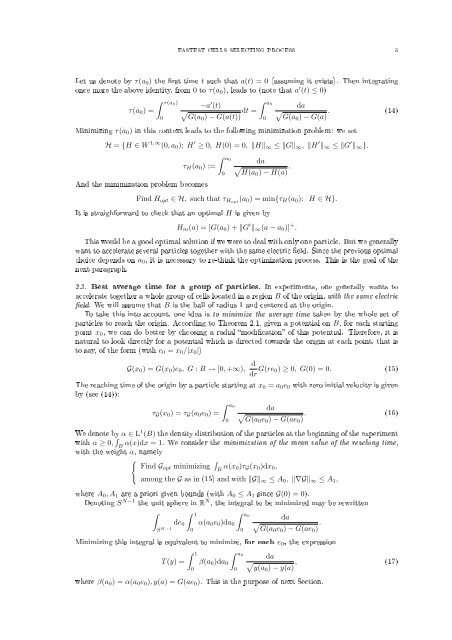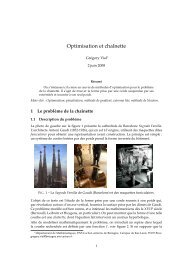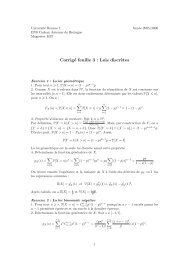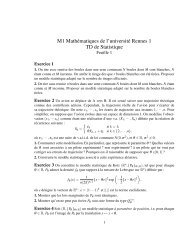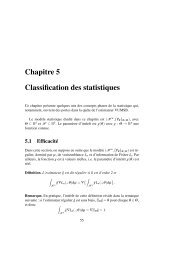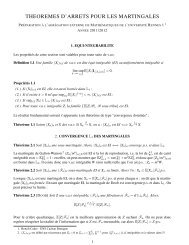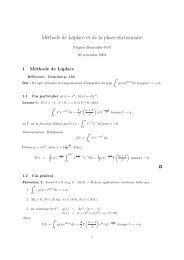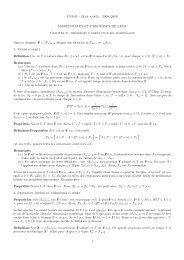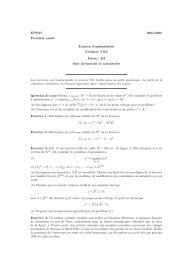best design for a fastest cells selecting process - ENS de Cachan ...
best design for a fastest cells selecting process - ENS de Cachan ...
best design for a fastest cells selecting process - ENS de Cachan ...
- No tags were found...
You also want an ePaper? Increase the reach of your titles
YUMPU automatically turns print PDFs into web optimized ePapers that Google loves.
FASTEST CELLS SELECTING PROCESS 5Let us <strong>de</strong>note by τ(a 0 ) the rst time t such that a(t) = 0 (assuming it exists). Then integratingonce more the above i<strong>de</strong>ntity, from 0 to τ(a 0 ), leads to (note that a ′ (t) ≤ 0)τ(a 0 ) =∫ τ(a0)0−a ′ ∫(t)a0√G(a0 ) − G(a(t)) dt = da√G(a0 ) − G(a) . (14)Minimizing τ(a 0 ) in this context leads to the following minimization problem: we setH = {H ∈ W 1,∞ (0, a 0 ); H ′ ≥ 0, H(0) = 0, ‖H‖ ∞ ≤ ‖G‖ ∞ , ‖H ′ ‖ ∞ ≤ ‖G ′ ‖ ∞ }.τ H (a 0 ) :=And the minimization problem becomes∫ a000da√H(a0 ) − H(a) .Find H opt ∈ H, such that τ Hopt (a 0 ) = min{τ H (a 0 ); H ∈ H}.It is straigh<strong>for</strong>ward to check that an optimal H is given byH m (a) = [G(a 0 ) + ‖G ′ ‖ ∞ (a − a 0 )] + .This would be a good optimal solution if we were to <strong>de</strong>al with only one particle. But we generallywant to accelerate several particles together with the same electric eld. Since the previous optimalchoice <strong>de</strong>pends on a 0 , it is necessary to re-think the optimization <strong>process</strong>. This is the goal of thenext paragraph.2.3. Best average time <strong>for</strong> a group of particles. In experiments, one generally wants toaccelerate together a whole group of <strong>cells</strong> located in a region B of the origin, with the same electriceld. We will assume that B is the ball of radius 1 and centered at the origin.To take this into account, one i<strong>de</strong>a is to minimize the average time taken by the whole set ofparticles to reach the origin. According to Theorem 2.1, given a potential on B, <strong>for</strong> each startingpoint x 0 , we can do better by choosing a radial modication of this potential. There<strong>for</strong>e, it isnatural to look directly <strong>for</strong> a potential which is directed towards the origin at each point, that isto say, of the <strong>for</strong>m (with e 0 = x 0 /|x 0 |)G(x 0 ) = G(x 0 )e 0 , G : B → [0, +∞),ddr G(re 0) ≥ 0, G(0) = 0. (15)The reaching time of the origin by a particle starting at x 0 = a 0 e 0 with zero initial velocity is givenby (see (14)):τ G (x 0 ) = τ G (a 0 e 0 ) =∫ a00da√G(a0 e 0 ) − G(ae 0 ) . (16)We <strong>de</strong>note by α ∈ L 1 (B) the <strong>de</strong>nsity distribution of the particles at the beginning of the experimentwith α ≥ 0, ∫ α(x)dx = 1. We consi<strong>de</strong>r the minimization of the mean value of the reaching time,Bwith the weight α, namely{Find Gopt minimizing ∫ B α(x 0)τ G (x 0 )dx 0 ,among the G as in (15) and with ‖G‖ ∞ ≤ A 0 , ‖∇G‖ ∞ ≤ A 1 ,where A 0 , A 1 are a priori given bounds (with A 0 ≤ A 1 since G(0) = 0).Denoting S N−1 the unit sphere in R N , the integral to be minimized may be rewritten∫ 1∫ a0da<strong>de</strong> 0 α(a 0 e 0 )da 0 √∫S N−1 G(a0 e 0 ) − G(ae 0 ) .0Minimizing this integral is equivalent to minimize, <strong>for</strong> each e 0 , the expressionT (y) =∫ 100β(a 0 )da 0∫ a00da√y(a0 ) − y(a) , (17)where β(a 0 ) = α(a 0 e 0 ), y(a) = G(ae 0 ). This is the purpose of next Section.


